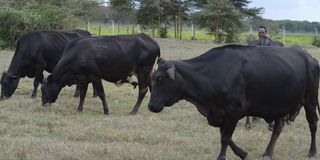Premium
Here is a new Asal dairy breed

A cross breed of Friesian and Sahiwal which is a new breed developed by Kenya Agricultural Livestock Research Organisation grazing at the Dairy Research Institute in Naivasha on January 31, 2022.
Farmers from arid and semi-arid parts of the country are set to benefit from a superior breed of dairy cows that is projected to boost their milk output.
The animals are a cross-breed of Holstein Friesian and Sahiwal developed at the Kenya Agricultural Livestock and Research Organisation (KALRO) Dairy Research Institute in Naivasha.
The new breed can produce an average of 30 litres of milk per day without a lot of intensive feeding.
Apart from high milk production, other notable performance indexes that are exciting the farmers and researchers include average lactation yield of 3,000 litres per lactation.
The age at first calving is at 33 months and has a calving interval of 420 days with a weaning age of three months.
Heifers from the cross breed are served at the weight of 340 kg which is between 22-24 months.
According to a researcher at the institute Dr Paul Leparmarai, the breed has few calving problems and is recommended for areas like Nakuru, Baringo, Koibatek, Kajiado, West Pokot, Machakos, Taita Taveta, parts of Nyeri and Elegeyo Marakwet.
Compared with small East African zebu which is the common breed in Asal areas, the new breed improves milk yield from five litres to 15 litres per day.
Cross breed
The body weight of the cross breed improves from 250kg live weight to 350kg and is resistant to diseases and harsh climatic conditions compared to exotic breeds of Friesian and Guernsey and Ayrshire that are susceptible to diseases.

A cross breed of Friesian and Sahiwal which is a new breed developed by Kenya Agricultural Livestock Research Organisation grazing at the Dairy Research Institute in Naivasha on January 31, 2022.
The age at first service is reduced from three years for local zebu to two years for the cross breed.
The new cross breed requirement for feed is less compared to Holstein Friesian that will demand more feed per litre of milk produced.
Karlo Director General Eliud Kireger has said the new breed, being developed at KALRO Naivasha Research Centre will soon be rolled out across the country.
"The breeding bulls are available at KALRO Naivasha Research Centre. We don't have enough bulls and we shall collaborate with Kenya Animal Genetic Resource Centre which is mandated to supply semen across the country to farmers. We have trained farmers on Artificial Insemination (AI) to spread the material to all farming communities," added Dr Kireger.
Farming communities
He added: "As a research organisation we support the farming communities of both livestock and agriculture by developing technologies, innovations, and management practices to increase production and that is why we have developed a duo purpose breed that produces both milk and meat."
He observed that milk and meat production in ASAL areas was low as the farmers face many challenges including lack of feeds, diseases, adaptability to those conditions, availability of quality stocks, and low adoption of technologies among other challenges.

A cross breed of Friesian and Sahiwal which is a new breed developed by Kenya Agricultural Livestock Research Organisation grazing at the Dairy Research Institute in Naivasha on January 31, 2022.
“The dairy technologies, innovations and management practices we're introducing like reproduction in dairy cattle breeding, disease tolerance, basal and supplementary forages, forage conservation, feed rations for improved production, fortification of feeds, milk value addition, manure management and aspect of the dairy business, cost benefit analysis and marketing, milk handling and processing and manure management for bioenergy will address these challenges," said Dr Kireger.
The Sh24.8 billion project under the National Agricultural and Rural Inclusive Growth Project (NARIGP) is funded by the World Bank and the government to increase agricultural productivity and profitability of targeted rural communities in selected counties.
Under NARIGP KALRO will train 500,000 farmers on a different aspect of the value chain and already it has registered over 600,000 farmers who are contacted via short text message on best agronomical practices.
21 counties
NARIG project is being undertaken in 21 counties and farmers in 17 counties of Turkana, Samburu, Makueni, Kitui, Embu, Meru, Kwale, Kilifi, Narok, Kirinyaga, Kiambu, Murang'a, Nakuru, Bungoma, Vihiga, Nandani, Trans Nzoia, Kisii, Nyamira, Migori and Homa Bay have been selected to promote dairy sub-sector, increase incomes, improve food and nutritional security especially for women, children, youth and vulnerable groups.
Dr Kireger noted that one of the weakest links between research and the farming community is the connection and transfer of technology from research to the smallholder farmers adding," to bridge this gap we're training extension officers so that they can train farmers as we cannot reach all the farmers in the country."
He said KALRO has set up a modern call centre where farmers can call and ask questions and information regarding their farming activities.
The lucrative dairy sub-sector contributes 3.5 per cent of the total Gross Domestic Product (GDP).
The current milk output is estimated at 5.2 billion litres per annum out of which 60 per cent is from grade dairy cattle and their crosses while the remaining 40 per cent comes from zebu, camel and goats.
The national dairy herd is estimated to be 3.3 million head, majority of which are grade cattle. One million smallholder farmers account for about 2.5million dairy cows producing over 80 per cent of total national milk output.
The informal milk sector accounts for more than 70 per cent of the 40,000 jobs in dairy marketing and supports over 350,000 others in formal employment.





